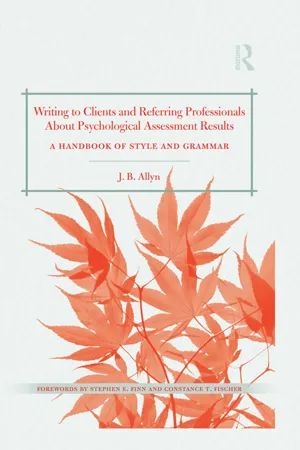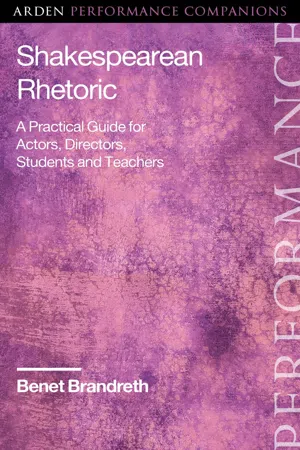Literature
Tone
In literature, "tone" refers to the author's attitude or feelings towards the subject matter. It is conveyed through the choice of words and the overall mood of the writing. The tone can be formal, informal, playful, serious, or any other emotional quality that shapes the reader's perception of the text.
Written by Perlego with AI-assistance
4 Key excerpts on "Tone"
- eBook - ePub
Writing to Clients and Referring Professionals about Psychological Assessment Results
A Handbook of Style and Grammar
- J. B. Allyn(Author)
- 2012(Publication Date)
- Routledge(Publisher)
“His Tone was flat” evokes all three—music, painting, and linguistics. Tone is a “manner of speaking or writing that shows a certain attitude on the part of the speaker or writer” (Webster’s, 2001). To convey attitude through Tone, a speaker uses an expanded range of skills not available to the writer. The speaker not only can use the vocal quality of Tone, as in the linguistic definition, but also can use facial expressions and other body language. In the example of the young person talking to her parent, she could display displeasure by rolling her eyes or slouching, arms crossed, in an “I don’t care” position, with one hip shifted sideways. The parent might stand upright, hands on hips with head and torso slightly forward, when chastising the girl. All of these would support the Tone used in speaking. A writer, however, must rely solely on words. And since we cannot directly convey in writing the pitch of a word in speech, we look for Tone to manifest in other ways. These contributors to Tone include formality in phrasing, accuracy and clarity in choice of words, selecting and arranging material, and juxtaposition of ideas. Table 2.1 lists these components of Tone and what defines them. The following sections explore them and give examples. Formality in Tone Building on attitude, as discussed in Chapter 1, Tone needs to match your knowledge of the reader and the material you are discussing. After you clarify for yourself your attitude toward the subject of your assessment and the recipient(s) of your report, you can more readily recognize the Tone you wish to take in writing to them. Formality is a straightforward place to begin. We can divide degree of formality in writing into three categories: popular or casual, conversational, and formal. Popular or casual writing aims to get a message across quickly—no muss, no fuss. It usually takes place between friends or people with some degree of personal connection - eBook - ePub
- Alan Gelb(Author)
- 2019(Publication Date)
- New World Library(Publisher)
He and I became committed collaborators and wound up liking each other very much. He went to Dartmouth and has had a very successful time of it. And why not? He was, as I’ve said, a smart and likable young man. I simply couldn’t allow his writing to undo that — and I have reason to believe that, going forward, he will avoid writing whose Tone makes him sound like someone he isn’t.ROUNDUP1. One of your primary goals as a writer is to capture your authentic voice. Tone becomes a significant issue in writing when it takes you away from that.2. You are encouraged to try a diagnostic exercise to identify the characteristics of your authentic voice — and to adjust those characteristics if need be.3. Writers often grapple with a Tone that is overly formal or informal.4. Informality rears its head with imperatives, contractions, qualifiers, and the use of colloquial words and expressions.5. One way that formality intrudes is when writers lapse into the passive voice.6. Metaphors and similes are useful writing tools, but can also lead writers into clichés and jargon, which can badly affect Tone.7. In order to eliminate clichés and jargon, writers must train themselves to “hear” stale expressions that the ear has been taught to tolerate.8. Never use internet acronyms in your writing.9. A solid vocabulary is a helpful tool in controlling Tone.10. Word collection, regularly using a dictionary, playing word games, and, most of all, reading are excellent ways to develop your vocabulary.11. - eBook - ePub
Shakespearean Rhetoric
A Practical Guide for Actors, Directors, Students and Teachers
- Benet Brandreth(Author)
- 2021(Publication Date)
- The Arden Shakespeare(Publisher)
19Style and Tone
Finally, another aspect of Style that is addressed in the classical texts is the overarching Tone of a speech. By ‘Tone’ I mean the feel of the language that is being used – for example, is it grand or common, full of fine words or plain and unadorned. (This overarching Tone is, confusingly, usually referred to as ‘style’ in the classical texts. Since this makes it difficult to distinguish from references to the overall canon of Style I prefer to use the term ‘Tone’.)The classical texts distinguish between three kinds of Tone: Grand, Middle and Simple:1The Grand Tone is ornate and smoothly complex. It adores long words, cleverly deployed in complex figures of thought.2The Simple Tone is plain and unadorned. It is the ordinary speech of everyday and is comfortable with slang and colloquialisms.3In between these two sits the Middle Tone, somewhat less ornate than the Grand but not yet the common speech of the Simple Tone.Why distinguish between Tones?
Rhetoric draws attention to these different Tones because, in a particular situation, it is usually appropriate to adopt one Tone over another. For example, a Grand Tone may suit a formal occasion – perhaps a funeral speech for a great leader. A Simple Tone is better suited to calming the angry mob. A Middle Tone may suit a declaration of love, where one wants to convey a certain sense of occasion but not appear over-blown.1 The Tone should match the occasion and the speaker. From the choice of Tone we can, therefore, learn something about both the speaker and the occasion. It is perhaps most revealing when the Tone jars with either the speaker or the occasion.Bad Tone
The classical texts caution that the three Tones sit dangerously close to bad style:1Grand Tone easily becomes what the Rhetorica Ad Herrenium calls ‘Swollen’ Tone. Instead of ornate language artfully employed in complex figures we get inflated language that overuses archaic or sesquipedalian2 - eBook - ePub
- Jeffrey Wainwright(Author)
- 2015(Publication Date)
- Routledge(Publisher)
Susan Howe (1937–), from ‘Pythagorean Silence’:age of earth and us all chatteringa sentence or character suddenlysteps out to seek for truth fails fallsinto a stream of ink Sequence trails offmust go onwaving fables and facesSummary In this chapter we have looked at:- What is meant by ‘Tone of voice’ in poetry and how different registers in speech can be said to correspond to different poetic styles.
- The relationship of speech to poetry and what we might mean by ‘natural’ and ‘unnatural’ style.
- The concept of the author’s authority, and authenticity in the poem.
- Public styles for poetry: narrative poetry and characterization.
- The Epic and the idea of the Muses in composition.
- Poems of anger, and satire.
- The simple voice in poetry and the pastoral style.
- Poetry as personal expression and the idea of the persona.
- The pressures of language on ‘free’ expression.
Further Reading
Brathwaite, E.K.(1973) The Arrivants: A New World Trilogy , Oxford: Oxford University Press.Brathwaite, E.K.(1995) History of the Voice: The Development of Nation Language in Anglophone Caribbean Literature , New York: New Beacon Books.Leech, G.N.(1969) A Linguistic Guide to English Poetry , Harlow: Longman, Introduction and Chapter 1.Mayes, F.(1987) The Discovery of Poetry , Orlando, FL: Harcourt, Brace, Jovanovich, see Chapter 4 ‘The Speaker: the Eye of the Poem’.Preminger, A. and Brogan, T.V.F.(eds)(1993) The New Princeton Encyclopedia of Poetry and Poetics
Index pages curate the most relevant extracts from our library of academic textbooks. They’ve been created using an in-house natural language model (NLM), each adding context and meaning to key research topics.
Explore more topic indexes
Explore more topic indexes
1 of 6
Explore more topic indexes
1 of 4



